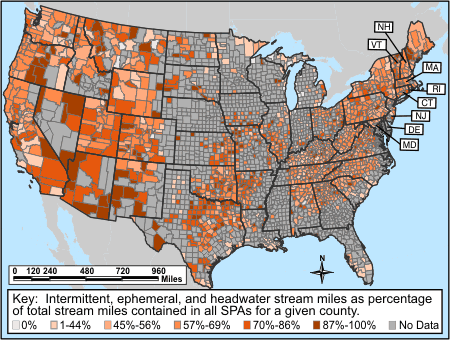Geographic Information Systems Analysis of the Surface Drinking Water Provided by Intermittent, Ephemeral, and Headwater Streams in the U.S.
This map shows the results of a series of geographic information systems (GIS) analyses examining the extent of different types of streams in the continental United States at the county level. The map was generated as part of an analysis aimed at illuminating regional patterns of dependence on intermittent, ephemeral and headwater streams for water to supply public drinking water systems in the United States, using the most recent, valid data available.
In the continental United States, about 117 million people, over one third of the total U.S. population, get some or all of their drinking water from public drinking water systems that rely at least in part on intermittent, ephemeral, or headwater streams. In the continental U.S., 357,404 total miles of streams provide water for public drinking water systems. Of that total, 58% (207,476 miles) are intermittent, ephemeral, or headwater streams. A more detailed summary of the analysis and breakdown of the results by state and by county are presented.
Click on your state to see the results:
Percentage of Surface Drinking Water from
Intermittent, Ephemeral, and Headwater Streams

- Summary of the analysis including purpose, methods, results, and data sources
- Interactive Drinking Water Map showing the the percent of the U.S. population that gets some of its drinking water directly or indirectly from streams that are intermittent, ephemeral or headwaters
- National Map by Counties
- State Maps
- Study results: data for each state
- Study results: data for each county
